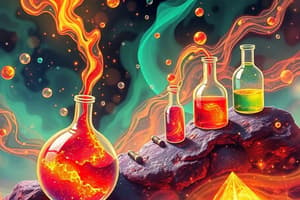Podcast
Questions and Answers
What color change occurs when a base is added to phenolphthalein?
What color change occurs when a base is added to phenolphthalein?
- It remains white
- It turns pink (correct)
- It turns yellow
- It turns blue
Which natural indicator turns reddish when mixed with an acid?
Which natural indicator turns reddish when mixed with an acid?
- Turmeric
- Onion
- Red cabbage juice (correct)
- Litmus
Which of the following indicators does NOT change its color with acid?
Which of the following indicators does NOT change its color with acid?
- Methyl orange
- Phenolphthalein
- Turmeric (correct)
- Litmus
What happens to the smell of vanilla when mixed with a base?
What happens to the smell of vanilla when mixed with a base?
What is a characteristic property of acids in aqueous solutions?
What is a characteristic property of acids in aqueous solutions?
Which acid is classified as a natural acid and is commonly found in vinegar?
Which acid is classified as a natural acid and is commonly found in vinegar?
What gas is produced when hydrochloric acid reacts with zinc metal?
What gas is produced when hydrochloric acid reacts with zinc metal?
Which of the following acids does NOT produce carbon dioxide when reacted with a metal carbonate?
Which of the following acids does NOT produce carbon dioxide when reacted with a metal carbonate?
Which of the following compounds represents a natural acid derived from citrus fruits?
Which of the following compounds represents a natural acid derived from citrus fruits?
When an acid reacts with a metal carbonate, which of the following is NOT a product of the reaction?
When an acid reacts with a metal carbonate, which of the following is NOT a product of the reaction?
Flashcards are hidden until you start studying
Study Notes
Indicators
- Substances that indicate acidity or basicity of a solution through color change.
Types of Indicators
Natural Indicators
- Derived from natural sources.
- Common examples include:
- Litmus: Obtained from lichens; purple in solution.
- Blue litmus turns red in acid; red turns blue in base.
- Turmeric: Yellow in color.
- Turns reddish-brown with a base; no color change with acid.
- Red Cabbage: Purple juice.
- Changes to reddish with acid; greenish with base.
- Litmus: Obtained from lichens; purple in solution.
Olfactory Indicators
- Change smell when mixed with acids or bases.
- Notable examples:
- Onion: Loses odor when added to base; retains smell with acid.
- Vanilla: Smell disappears with base; unaffected by acid.
Synthetic Indicators
- Created in the laboratory.
- Examples include:
- Phenolphthalein: Colorless in acid; turns pink in base.
- Methyl Orange: Orange initially; appears red in acid and yellow in base.
Acids
- Characterized by sour taste and the ability to turn blue litmus red; they dissociate to release H+ ions in water.
- Common examples:
- Sulphuric acid (H2SO4)
- Acetic acid (CH3COOH)
- Nitric acid (HNO3)
Properties of Acids
- Sour taste.
- Blue litmus turns red.
- Conduct electricity in solution.
- Release H+ ions when dissolved in water.
Types of Acids
- Natural (Organic) Acids: Obtained from natural sources.
- Examples:
- Methanoic acid (HCOOH)
- Acetic acid (Vinegar)
- Citric acid (Citrus fruits)
- Examples:
- Mineral Acids: Prepared from minerals; also known as inorganic or synthetic acids.
- Examples:
- Hydrochloric acid (HCl)
- Sulphuric acid (H2SO4)
- Nitric acid (HNO3)
- Examples:
Chemical Properties of Acids
-
Reaction with Metals: Produces hydrogen gas and respective salt.
- For example, reaction of hydrochloric acid with zinc yields zinc chloride and hydrogen gas.
-
Reaction with Metal Carbonates: Yields carbon dioxide gas, water, and respective salts.
- Example with hydrochloric acid and sodium carbonate results in sodium chloride, carbon dioxide, and water.
Testing for Hydrogen Gas
- Presence of hydrogen gas confirmed by bringing a lighted candle near the test; it burns with a pop sound, indicating hydrogen evolution.
Studying That Suits You
Use AI to generate personalized quizzes and flashcards to suit your learning preferences.




